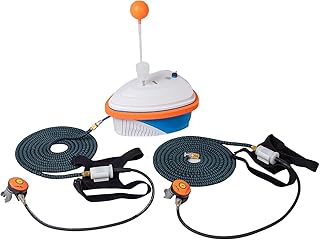A Scuba regulator is a critical piece of life-support equipment that allows a diver to breathe from a scuba tank by automatically providing air at the correct pressure corresponding to the surrounding water pressure. It is a marvel of precision engineering that performs a vital function: delivering air effortlessly, whenever the diver inhales.
Core Principle: Demand Valve Mechanism
The fundamental principle is the demand valve. This mechanism detects when a diver inhales (creating a slight negative pressure) and opens a valve to deliver air from the tank only when needed. It also reduces the high-pressure air from the tank (which can be over 200 bar/3000 psi) to ambient pressure.
Key Components and Their Functions
A typical scuba regulator is a two-stage system:
First Stage: This part attaches directly to the tank valve.
Function: Its job is to reduce the tank's high pressure (e.g., 200 bar) to an intermediate pressure (typically 8-10 bar above the surrounding water pressure).
Types:
Piston: Simple, robust, and high-performing. Uses a mechanical piston that opens and closes directly with inhalation and exhalation. Known for high airflow.
Diaphragm: More complex but better sealed from the environment. The diaphragm acts as a barrier between the water and the internal mechanism, making it ideal for cold or dirty water.
Second Stage: This is the part the diver puts in their mouth.
Function: It reduces the intermediate pressure from the first stage to ambient pressure—the exact pressure of the water surrounding the diver. It only does this when the diver inhales.
Key Parts:
Purge Button: When pressed, it forces air into the second stage, clearing any water out through the exhaust vents.
Air Barrel/Levers: Contains the mechanism that opens the valve when the diver inhales. High-performance regulators use multiple levers to reduce inhalation effort.
Mouthpiece: Fits in the diver's mouth, typically made of soft silicone for comfort.
Exhaust Tee: Channels exhaled air downwards and away from the diver's field of vision.
Other Essential Components:
Low-Pressure (LP) Ports: These outlets on the first stage provide intermediate-pressure air to power accessories like the Buoyancy Control Device (BCD) inflator, a backup second stage (octopus), and a drysuit inflator.
High-Pressure (HP) Port: This outlet provides a reduced but still high-pressure stream of air to the submersible pressure gauge (SPG), which tells the diver how much air remains in the tank.
Alternate Air Source (Octopus): A backup second stage, distinctly colored (usually yellow), that allows another diver to share air in an emergency.
Hoses: Flexible, reinforced tubes that carry air between the components.
The Breathing Cycle: Step-by-Step
Inhalation: The diver inhales, creating a slight vacuum inside the second stage.
Valve Activation: This vacuum pulls a diaphragm or lever inside the second stage, which physically opens the valve.
Air Delivery: Intermediate-pressure air from the first stage rushes through the hose and into the second stage, where its pressure is dropped to ambient water pressure before entering the diver's lungs.
Exhalation: The diver exhales. The pressure from the exhalation closes the demand valve in the second stage and opens a one-way exhaust valve, allowing the used air to bubble out into the water.
The cycle repeats.
Advantages of a Modern Regulator
Automatic Operation: It works effortlessly, requiring no conscious thought from the diver.
Reliability: Designed and tested to the highest safety standards (e.g., EN250), they are incredibly reliable with proper maintenance.
Comfort and Performance: Modern regulators are designed for minimal inhalation effort (work of breathing), even at great depths, and are balanced to provide consistent airflow regardless of tank pressure.
Environmental Sealing: Diaphragm first stages can be environmentally sealed, preventing freezing in cold water and keeping silt and contaminants out.
Limitations and Important Considerations
Free-Flows: In very cold water or if malfunctioning, a regulator can free-flow, releasing a continuous stream of air. Divers are trained to manage this.
Maintenance is Critical: Regulators require annual servicing by a certified technician to ensure all O-rings, seals, and moving parts are in perfect condition. A failure is life-threatening.
Breathing Resistance: While minimal, there is always a slight resistance to inhalation and exhalation, which can increase with depth and workload.
Dependence on Air Supply: The regulator is useless without a pressurized air source.
Special Features and Technological Advancements
Swivels: Swivel joints on hoses or at the second stage connection improve comfort and reduce hose drag.
Adjustable Breathing Resistance: Some second stages have a dial to make inhalation harder or easier, helping to prevent free-flows when not in the mouth or to fine-tune performance.
Downstream Design: The air flow pushes the valve open. This is a crucial safety feature; if the first stage fails and sends high pressure down the hose, the downstream valve will be forced open, resulting in a free-flow that the diver can see and hear, rather than a dangerous blockage.
The scuba regulator is not a "ventilator" but a sophisticated, self-contained breathing apparatus. It is the diver's literal lifeline, transforming a tank of compressed gas into a seamless, on-demand source of breathable air. Its reliable, automatic operation is what makes exploring the underwater world possible. The combination of robust engineering, fail-safe design principles, and ergonomic comfort makes the modern regulator one of the most important and impressive pieces of equipment in any diver's kit.
 |  |  |
 |  |  |
